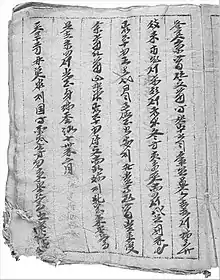لغه مونجولى
لغه مونجولى (مونجولى اصلى:ᠮᠣᠩᠭᠣᠯᠬᠡᠯᠡ) (مونجولى روسى:Монгол хэл), دى لغه اللى بيتكلم مونجول حوالى 5.7 مليون انسان, ودى متقسمه لاربع مناطق واللى هى مونجوليا الداخلى بالصين, مونجوليا, كازاخستان وروسيا, لكن الفرق المعروفه ان مونجوليين صينيين لسه بيكتبوا ابجدى مونجولى القياسى اللى موجوده من آلالاف سنين, ودوله مونجوليا اللى سابت لغه اجداده وبدلت ابجديه المونجولى الاصلى بالمونجولى الروسى علشان يسهل الكتابه, ودُوُل متآثرين بالثقافه الروسى.
| Mongolian | |
|---|---|
| монгол хэл ᠮᠣᠩᠭᠣᠯ ᠬᠡᠯᠡ | |
| Pronunciation | /mɔŋɢɔ̆ɮ xeɮ/ |
| Native to | Mongolia |
| Region | All of state Mongolia and Inner Mongolia, parts of Liaoning, Jilin, Heilongjiang, Xinjiang and Gansu provinces in China |
Native speakers | 5.2 million (2005)[1] |
Mongolic
| |
Early forms | Middle Mongolian
|
Standard forms |
|
| Dialects |
|
| Mongolian alphabets: Traditional Mongolian script (in China), Mongolian Cyrillic alphabet (in Mongolia), Mongolian Braille | |
| Official status | |
Official language in | قالب:بيانات بلد Mongolia
|
| Regulated by | Mongolia: State Language Council,[3] China: Council for Language and Literature Work[4] |
| Language codes | |
| ISO 639-1 | mn |
| ISO 639-2 | mon |
| ISO 639-3 | mon – inclusive codeIndividual codes: khk – Khalkha Mongolian mvf – Peripheral Mongolian (part) |
| Glottolog | mong1331 |
| Linguasphere | part of 44-BAA-b |
 Topographic map showing Asia as centered on modern-day Mongolia and Kazakhstan. An orange line shows the extent of the Mongol Empire. Some places are filled in red. This includes all of Mongolia, most of Inner Mongolia and Kalmykia, three enclaves in Xinjiang, multiple tiny enclaves round Lake Baikal, part of Manchuria, Gansu, Qinghai, and one place that is west of Nanjing and in the south-south-west of Zhengzhou Geographic distribution of Mongolic peoples across Asia (red) | |

دى اقدم لغه مونجولى القديم
اماكن بيكتبوا مونجولى الاصلى
هى موجوده بس فى مونجوليا الداخلى بالصين فى مقاطعات هيلونغجيانج, جيلين ولياونينج.[5][6][7]
مراجع
- "China". Ethnologue.
- "Törijn alban josny helnij tuhaj huul'". MongolianLaws.com. 2003-05-15. Archived from the original on 2009-08-22. Retrieved 2009-03-27.
{{cite web}}: Unknown parameter|deadurl=ignored (help) The decisions of the council have to be ratified by the government. - "Mongγul kele bičig-ün aǰil-un ǰöblel". See Sečenbaγatur et al. 2005: 204.
- Tsung, Linda (October 27, 2014). "3". Language Power and Hierarchy: Multilingual Education in China. Bloomsbury Academic.
- Tsung, Linda (October 27, 2014). "3". Language Power and Hierarchy: Multilingual Education in China. Bloomsbury Academic. p. 59.
- Baabar (2008-12-09). "Yum bolgon nertei". Ödriin sonin.
{{cite web}}: Missing or empty|url=(help)
مصدر
لينكات برانيه
قالب:Wiktionarycat قالب:Wikibook
دليل a phrasebook لMongolian.
- Lingua Mongolia (a website dedicated to the Mongolian language, mostly as written in the Mongolian Uyghur script) Archived 2022-03-19 at the Wayback Machine
- Bolor Mongolian-English dictionary
This article is issued from Wikipedia. The text is licensed under Creative Commons - Attribution - Sharealike. Additional terms may apply for the media files.